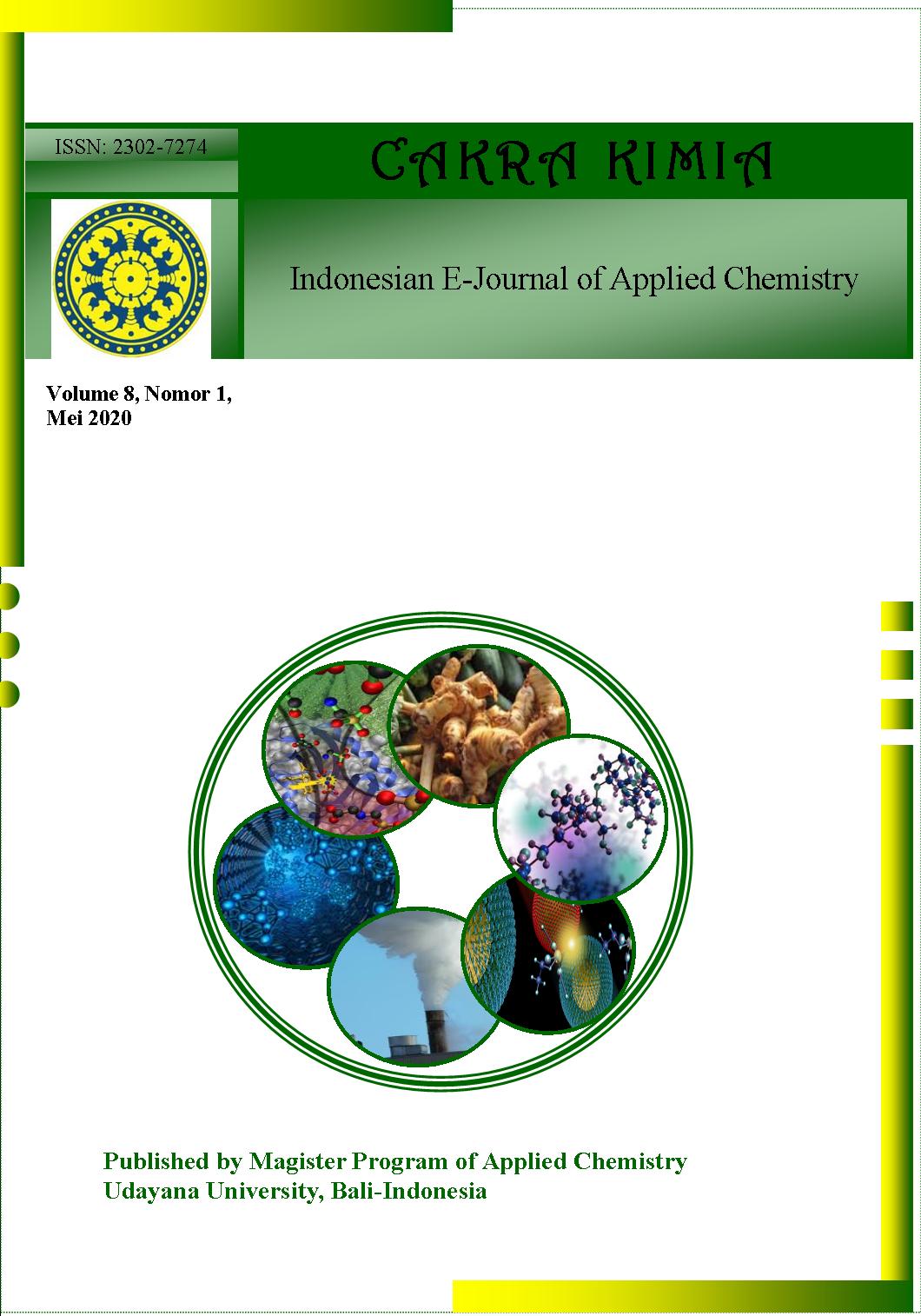EFEKTIVITAS NANOPARTIKEL PERAK (NPAg) UNTUK FOTODEGRADASI ZAT WARNA INDIGOSOL BLUE
Abstract
ABSTRAK: Biosintesis nanopartikel merupakan alternatif dari metode kimia dan fisika yang hemat biaya dan ramah lingkungan. Penelitian ini bertujuan untuk mengetahui efektivitas nanopartikel perak (NPAg) dalam mendegradasi zat warna Indigosol Blue. Nanopartikel perak disintesis menggunakan ekstrak air buah andaliman (zanthoxylum acanthopodium DC.). Ekstrak ini mempunyai fungsi sebagai agen pereduksi dan penstabil dari biosintesis nanopartikel perak. Ekstrak air buah andaliman ditambahkan ke larutan AgNO3 1 x10-3 M kemudian pembentukan NPAg diamati menggunakan spektrofotometer UV-Vis dengan puncak pada 442 nm. Ukuran partikel NPAg diamati menggunakan PSA (Particle size analyzer) dan diperoleh ukuran NPAg yang sangat kecil yaitu lebih kecil dari 40 nm. Efektivitas fotokatalitik NPAg terhadap Indigosol Blue sangat baik dimana NPAg mampu mendegradasi Indigosol Blue sampai konsentrasi 700 ppm.
ABSTRACT: Biosynthesis of nanoparticle is an alternative to chemical and physical methods that are cost effective and environmentally friendly. This study aims to determine the effectiveness of NPAg to degrade Indigosol Blue dyes. The biosynthesis of silver nanoparticles has been carried out using andaliman fruit water extract (zanthoxylum acanthopodium DC.). This extract has a function as a reducing and stabilizing agent for the biosynthesis of silver nanoparticles. Andaliman fruit water extract was added to AgNO3 1 x10-3 M solution then NPAg formation was observed using a UV-Vis spectrophotometer with absorbance peak at 442 nm. NPAg particle sizes observed using particle size analyzer were less than 40 nm. The effectiveness of photocatalytic NPAg against Indigosol Blue is high where NPAg is able to degrade Indigosol Blue up to concentration of 700 ppm.
Downloads
References
[2] Daniel, M.C. and Astruc, D., 2004. Gold Nanoparticles: Assembly, Supramolecular Chemistry, Quantum-Size-Related Properties, and Applications Toward Biology, Catalysis, and Nanotechnology. Chem. Rev., 104(1): 293 – 346
[3] Ankamwar, B., Chaudhary, M. and Mural, S., 2005. Gold Nanotriangles Biologically Synthesized Using Tamarind Leaf Extract and Potential Application in Vapour Sensing. Synth. React. Inorg. Met. Org. Chem., 35: 19 – 26
[4] Jyoti, K., & Singh, A. 2016. Green Synthesis of Nanostructured Silver Particles and Their Catalytic Application in Dye Degradation. Journal of Genetic Engineering and Biotechnology, 14(2): 311–317 https://doi.org/10.1016/j.jgeb.2016.09.005
[5] Daneshvar, N., Ayazloo, M., Khataee, A.R., and Pourhassan, M., 2007. Biological Decolourisation of Dye Solution Containing Malachite Green by Microalgae Cosmarium sp. Bioresource Technology, 98(6): 1176 – 1182.
[6] Mohamed, R.M., Mkhalid, I.A., Baeissa, E.S., and Al-Rayyani, M.A., 2012. Photocatalytic Degradation of Methylene Blue by Fe/ZnO/SiO2 Nanoparticles Under Visible Light. J. of Nanotech., 2012, Article ID 329082, 5 pages. Doi:10.1155/2012/329082
[7] Wang, P., Huang, B., Qin, X., Zhang, X., Dai, Y., Wei, J., and Whangbo, M.H., 2008. Efficient and Stable Photocatalyst Under Visible Light. Chem. Eur. J., 14: 10543–10546
[8] Yousefzadi, M., Rahimi, Z. dan Ghafori, V., 2014. The Green Synthesis, Characterization and Antimicrobial Activities of Silver Nanoparticles Synthesized from Green Alga Enteromorpha flexuosa (wulfen) J.Agardh. Mater. Lett. 137: 1 – 4
[9] Willets, K.A., Hall, W.P., Sherry, L.J., Zhang, X., Zhao, J. dan Duyne, R.P.V., 2007. Nanoscsale Localized Surface Plasmon Resonance Biosensors. Nanobiotech. II: 159-173
[10] Jiang X.C, Chen, W.M., Chen, C.Y., Xiong, S.X., Yu, A.B., 2011. Role of Temperature in The Growth of Silver Nanoparticles Through a Synergetic Reduction Approach. Nanoscale Research Letters, 6(1): 32–40
[11] Yong JS, Beom SK. 2009. Rapid Biological Synthesis of Silver Nanoparticles Using Plant Leaf Extracts. Bioprocess Biosyst Engineering, 32(1): 79–84
[12] Iravani S. 2011. Green Synthesis of Metal Nanoparticles Using Plants. Green Chemistry. Critical Review.,13: 2638–2650
[13] Huang, J., Li, Q., Sun, D., Lu, Y., Su, Y., Yang, X., Wang, H., Wang, Y., Shao, W., Ning, H., Hong, J., Chen, C., 2007. Biosynthesis Of Silver And Gold Nanoparticles By Novel Sundried Cinnamomum camphora Leaf, Nanotech. 18(10): 105104 – 105115
[14] Adam R, Pozina G, Willander M, Nur O., 2018. Synthesis of ZnO Nanoparticles by Co-precipitation Method for Solar Driven Photodegradation of Congo Red Dye at Different pH. Photonics and Nanostructures-Fundamental and Applications, 32(2018): 11–18 http://doi.org/10.1016/j.photonics.2018.08.005



 Petunjuk Penulisan
Petunjuk Penulisan
